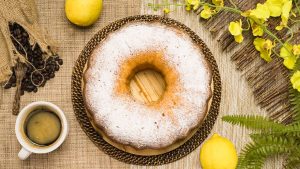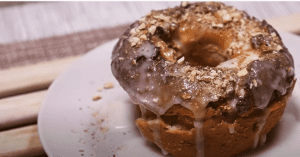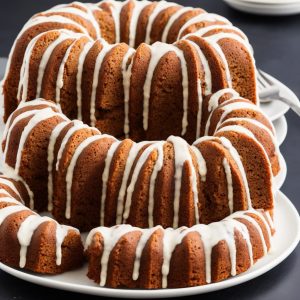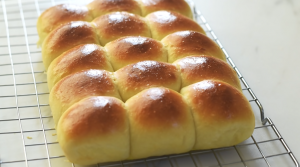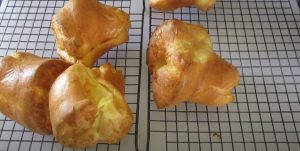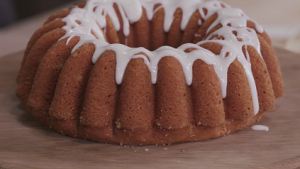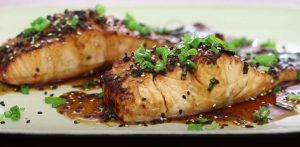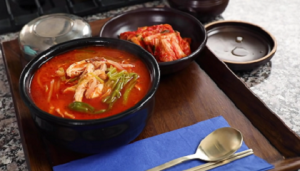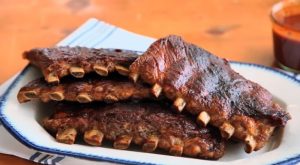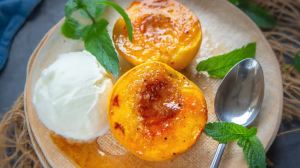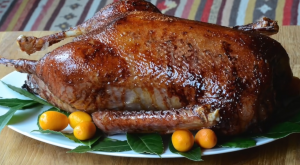Indulge in the delightful flavors of this glazed orange bundt cake, perfect for any occasion. With its moist texture and zesty citrus notes, this cake is sure to impress your family and friends. The easy orange glaze adds an extra touch of sweetness, making each bite a true treat.
Photos of Glazed Orange Bundt Cake Recipe
For this recipe, you might need to pick up a few essentials that aren't always stocked in every kitchen. Cake flour provides a finer, lighter crumb compared to all-purpose flour. Buttermilk adds a tangy flavor and helps achieve a tender texture. Fresh orange zest and orange juice are crucial for that vibrant citrus taste. Make sure to stock up on these when you head to the supermarket.
Ingredients for Glazed Orange Bundt Cake
Cake flour: Provides a finer, lighter crumb for the cake.
Salt: Enhances the flavors in the cake.
Baking powder: Helps the cake rise and become fluffy.
Baking soda: Works with the acidic ingredients to help the cake rise.
Butter: Adds richness and moisture to the cake.
Granulated sugar: Sweetens the cake and helps with the texture.
Eggs: Provide structure and stability to the cake.
Pure vanilla extract: Adds flavor depth and aroma.
Orange zest: Infuses the cake with bright, citrus flavor.
Orange juice: Adds moisture and a fresh citrus taste.
Buttermilk: Adds tanginess and tenderness to the cake.
Confectioner's sugar: Sweetens the glaze and gives it a smooth texture.
Fresh orange juice: Adds citrus flavor to the glaze.
Pure vanilla extract: Enhances the flavor of the glaze.
One reader, Kyle Lawler says:





This glazed orange bundt cake recipe is a citrus delight! The cake is moist and bursting with fresh orange flavor, while the glaze adds the perfect sweet touch. It's easy to make and looks stunning. A definite crowd-pleaser!
Techniques Required for Making a Glazed Orange Bundt Cake
Yes.
How to zest an orange: Use a microplane or fine grater to remove the outer layer of the orange peel, avoiding the white pith underneath. How to cream butter and sugar: Beat the butter and sugar together at high speed until the mixture is light and fluffy, usually taking about 2-3 minutes. How to alternate dry and wet ingredients: Add the dry ingredients in portions, alternating with the wet ingredients, mixing just until each addition is incorporated to avoid overmixing. How to invert a bundt cake: Allow the cake to cool slightly in the pan, then place a wire rack over the top of the pan and flip it over to release the cake onto the rack. How to make a glaze: Whisk together confectioners' sugar, orange juice, and vanilla until smooth, adjusting the consistency with more juice if necessary.
How To Make Glazed Orange Bundt Cake
Delightfully fluffy, orange-y, and bright in color, this Orange Bundt Cakes is generously made creamy and glazed with a tasty and easy-to-make orange glaze!
Serves:
Ingredients
- 3cupscake flour,sifted, spooned, leveled
- 1tspsalt
- 1tspbaking powder
- ½tspbaking soda
- 1cupbutter,unsalted, softened to room temperature
- 1⅔cupsgranulated sugar
- 4large eggs,at room temperature
- 1tsppure vanilla extract
- 2tbsporange zest,(from about 2 oranges)
- ½cuporange juice,(from about 2 oranges)
- ¾cupbuttermilk,at room temperature
For Easy Orange Glaze:
- 1¼cupsconfectioner’s sugar,sifted
- 3tbspfresh orange juice
- ½tsppure vanilla extract
Instructions
-
Lower the oven rack to the lower third position and preheat the oven to 350°F (177°C). Spray the inside of a 10 inch bundt pan with nonstick spray or grease thoroughly with butter. Set aside.
Cake:
-
Whisk the flour, salt, baking powder, and baking soda together. Set aside.
-
Using a handheld or stand mixer fitted with a paddle attachment, beat the butter on high speed until smooth and creamy – about 1 minute.
-
Add the sugar and beat on high speed for 2 minutes until creamed together.
-
Scrape down the sides and up the bottom of the bowl with a rubber spatula as needed.
-
Add the eggs and the vanilla. Beat on medium-high speed until combined. Scrape down the sides and up the bottom of the bowl as needed.
-
Beat in the orange zest and juice.
-
With the mixer on low speed, add the dry ingredients in three additions alternating with the buttermilk and mixing each addition just until incorporated.
-
Do not overmix. The batter will be slightly thick.
-
Pour or spoon the batter evenly into the bundt pan. Bake for 45 to 55 minutes or until a toothpick inserted into the cake comes out clean.
-
Cover the cake loosely with aluminum foil if you begin to see the top browning quickly.
-
Once done, remove from the oven and allow to cool for 10 minutes inside the pan.
-
Invert the slightly cooled bundt cake onto a wire rack set over a large plate or serving dish.
-
Allow cake to cool before glazing and serving.
Easy Orange Glaze:
-
Whisk the confectioners’ sugar, 2 tablespoons of orange juice, and vanilla together. It will be very thick.
-
Whisk in 1 or more tablespoons of juice, depending on the desired thickness of the glaze.
-
Drizzle over the cake.
-
Slice and serve.
Recipe Notes
- Make-Ahead & Freezing Instructions: Prepare cake through step 14. Cover the cake tightly and refrigerate for up to 2 days or freeze up to 2 months. Bring to room temperature, make the glaze, and serve.
- Cake Flour: Sift cake flour before measuring.
- Buttermilk: It is recommended to use real buttermilk in this recipe. Or use a DIY soured milk. To do so, simply add 1½ teaspoons of white vinegar or fresh lemon juice to a liquid measuring cup and enough whole or 2% milk to reach ¾ cup. Allow the mixture to sit for 5 minutes, then use in the recipe. Lower fat or non-dairy kinds of milk work in a pinch, but the cake won’t taste as rich and moist.
- Instead of baking in a bundt pan, bake in two 9×5-inch loaf pans. The bake time for each will be about 45 to 50 minutes at 350 degrees F.
Nutrition
- Calories: 545.73kcal
- Fat: 20.87g
- Saturated Fat: 12.44g
- Trans Fat: 0.75g
- Monounsaturated Fat: 5.59g
- Polyunsaturated Fat: 1.24g
- Carbohydrates: 83.66g
- Fiber: 0.86g
- Sugar: 50.55g
- Protein: 6.82g
- Cholesterol: 123.94mg
- Sodium: 395.51mg
- Calcium: 82.09mg
- Potassium: 142.56mg
- Iron: 3.50mg
- Vitamin A: 191.80µg
- Vitamin C: 10.34mg
Technique Tip for Making the Perfect Glazed Orange Bundt Cake
To ensure your bundt cake releases cleanly from the pan, generously grease every nook and cranny with butter or nonstick spray, then lightly dust with flour. This creates a barrier that prevents sticking and helps achieve a smooth, professional finish.
Time-Saving Tips for Making This Glazed Orange Bundt Cake Recipe
Pre-measure ingredients: Measure and prepare all ingredients in advance to streamline the baking process.
Use a stand mixer: A stand mixer can save time and effort when creaming butter and sugar, and mixing batter.
Zest and juice together: Zest the oranges before juicing to save time and reduce mess.
Prepare the pan: Grease the bundt pan thoroughly before starting to avoid delays.
Cool efficiently: Allow the cake to cool in the pan for 10 minutes before inverting to speed up the cooling process.
Substitute Ingredients For Glazed Orange Bundt Cake Recipe
cake flour - Substitute with all-purpose flour: Use 2¾ cups of all-purpose flour plus ¼ cup of cornstarch to mimic the lighter texture of cake flour.
salt - Substitute with kosher salt: Use the same amount, but note that kosher salt has a coarser grain, so it may slightly alter the texture.
baking powder - Substitute with baking soda and cream of tartar: Use ¼ tsp baking soda plus ½ tsp cream of tartar for every 1 tsp of baking powder.
baking soda - Substitute with baking powder: Use 4 times the amount of baking powder, but this may affect the flavor slightly.
butter - Substitute with margarine: Use the same amount, but margarine may alter the flavor and texture slightly.
granulated sugar - Substitute with coconut sugar: Use the same amount, but coconut sugar will add a caramel-like flavor and darker color.
large eggs - Substitute with flax eggs: Mix 1 tbsp ground flaxseed with 3 tbsp water per egg, let it sit for a few minutes to thicken.
pure vanilla extract - Substitute with vanilla bean paste: Use the same amount, but vanilla bean paste will add a richer vanilla flavor.
orange zest - Substitute with lemon zest: Use the same amount, but lemon zest will give a slightly different citrus flavor.
orange juice - Substitute with lemon juice: Use the same amount, but lemon juice will be more tart.
buttermilk - Substitute with milk and vinegar: Mix ¾ cup milk with ¾ tbsp vinegar or lemon juice, let it sit for 5 minutes to curdle.
confectioner's sugar - Substitute with granulated sugar: Blend granulated sugar in a blender until it becomes a fine powder.
fresh orange juice - Substitute with store-bought orange juice: Use the same amount, but fresh juice is preferable for better flavor.
pure vanilla extract - Substitute with almond extract: Use half the amount, as almond extract is stronger in flavor.
Presenting Your Glazed Orange Bundt Cake
Use a pristine white plate: Choose a large, pristine white plate to make the vibrant colors of the glazed orange bundt cake pop. The simplicity of the white background will highlight the cake's golden hue and the glossy orange glaze.
Slice with precision: Cut the bundt cake into even slices using a sharp knife. Each slice should be about 1.5 inches thick to ensure a generous portion without overwhelming the plate.
Drizzle the glaze artistically: Instead of simply pouring the orange glaze over the cake, use a spoon to drizzle it in a zigzag pattern over each slice. This adds a touch of elegance and ensures each bite has a bit of glaze.
Garnish with fresh elements: Add a few thin slices of fresh orange and a sprig of mint to the plate. The fresh orange slices will echo the flavors of the cake, while the mint adds a pop of color and a refreshing aroma.
Add a dusting of confectioner's sugar: Lightly dust the plate and the edges of the cake slices with confectioner's sugar. This adds a delicate, snowy effect that enhances the visual appeal.
Serve with a side of whipped cream: Place a small dollop of whipped cream next to each slice of cake. The creaminess of the whipped cream complements the citrusy notes of the orange bundt cake.
Use edible flowers: Decorate the plate with a few edible flowers, such as pansies or violets. These flowers add a touch of sophistication and a burst of color, making the dish look even more enticing.
Create height with cake layers: If possible, stack two slices of the bundt cake slightly offset from each other. This creates height and dimension on the plate, giving it a more dynamic and professional presentation.
Serve with a citrus sauce: Prepare a small amount of citrus sauce using orange juice, lemon juice, and a bit of sugar. Drizzle this sauce around the plate for an extra layer of flavor and a beautiful, glossy finish.
Finish with a touch of zest: Grate a small amount of orange zest over the top of the cake slices just before serving. This adds a burst of fresh citrus aroma and a final touch of color.
Essential Tools for Making a Glazed Orange Bundt Cake
Oven: Preheat to 350°F (177°C) and bake the cake.
10 inch bundt pan: Use to bake the bundt cake, ensuring it has a beautiful shape.
Nonstick spray or butter: Grease the bundt pan to prevent the cake from sticking.
Handheld or stand mixer: Beat the butter, sugar, eggs, and other ingredients to create a smooth batter.
Paddle attachment: Attach to the mixer to cream the butter and sugar together.
Whisk: Combine the dry ingredients and mix the glaze.
Rubber spatula: Scrape down the sides and bottom of the mixing bowl to ensure all ingredients are well incorporated.
Mixing bowl: Hold and mix the cake batter and dry ingredients.
Measuring cups: Measure out the flour, sugar, buttermilk, and other ingredients accurately.
Measuring spoons: Measure smaller quantities of ingredients like salt, baking powder, and vanilla extract.
Zester: Obtain fresh orange zest for the cake batter.
Juicer: Extract fresh orange juice for the cake and glaze.
Toothpick: Test the cake for doneness by inserting it into the center.
Aluminum foil: Cover the cake if it starts to brown too quickly.
Wire rack: Cool the cake after baking to prevent it from becoming soggy.
Large plate or serving dish: Place under the wire rack to catch any excess glaze.
Knife: Slice the cake for serving.
Storing and Freezing Your Glazed Orange Bundt Cake
- Allow the glazed orange bundt cake to cool completely before storing or freezing.
- To store the cake at room temperature, wrap it tightly in plastic wrap or aluminum foil. It will keep for up to 3 days.
- For longer storage, place the wrapped cake in an airtight container or freezer bag and store it in the refrigerator for up to 1 week.
- To freeze the cake, follow these steps:
- Wrap the cooled cake tightly in plastic wrap, making sure to cover all sides.
- Wrap the cake again in aluminum foil or place it in a freezer-safe container.
- Label the container with the date and contents.
- Freeze the bundt cake for up to 3 months.
- To thaw the frozen cake, remove it from the freezer and let it thaw in the refrigerator overnight or at room temperature for several hours.
- If the cake is unglazed, you can glaze it after thawing for a fresh appearance and taste.
- If the cake is already glazed, be aware that the glaze may absorb into the cake during the freezing and thawing process, affecting its appearance. However, it will still taste delicious.
- For best results, consume the thawed orange bundt cake within 2-3 days.
How To Reheat Leftover Glazed Orange Bundt Cake
Preheat your oven to 350°F (175°C). Place the leftover glazed orange bundt cake on a baking sheet lined with parchment paper or aluminum foil. Cover the cake loosely with another piece of foil to prevent it from drying out or browning too much. Heat the cake in the oven for 10-15 minutes, or until it's warmed through.
For a quicker reheating method, place a slice of the bundt cake on a microwave-safe plate. Heat it in the microwave on medium power for 20-30 seconds, or until it's warm and soft. Be careful not to overheat the cake, as it can become rubbery or tough.
If you want to restore some of the moisture to the cake, try steaming it. Fill a pot with about an inch of water and bring it to a simmer. Place the cake slice on a heatproof plate and set it on top of the pot, making sure the water doesn't touch the plate. Cover the pot with a lid and steam the cake for 3-5 minutes, or until it's soft and moist.
For a crispy exterior and a soft, warm interior, try reheating the orange bundt cake in an air fryer. Preheat the air fryer to 350°F (175°C) and place a slice of the cake in the basket. Cook for 2-3 minutes, or until the cake is heated through and the outside is slightly crispy.
If you want to add some extra orange flavor to the cake, try brushing it with a mixture of orange juice and confectioner's sugar before reheating. This will create a fresh glaze and infuse the cake with a bright, citrusy taste.
Random Fact About Glazed Orange Bundt Cakes
A bundt cake gets its name from the distinctive ring-shaped pan it is baked in, which was inspired by a traditional European cake known as Gugelhupf.
Is Making a Glazed Orange Bundt Cake Economical for Home Cooking?
This glazed orange bundt cake recipe is relatively cost-effective for a household. The primary ingredients such as cake flour, butter, sugar, and eggs are common pantry items, while orange zest and orange juice add a fresh, zesty flavor without significantly increasing the cost. The approximate cost for a household of 4 people is around $10-$12 USD. Overall Verdict: 8/10.
Is This Glazed Orange Cake Healthy or Unhealthy?
The glazed orange bundt cake recipe, while undeniably delicious, is not particularly healthy. The cake itself is made with a significant amount of butter, sugar, and refined flour, which are all high in calories and low in nutrients. The glaze, made with confectioner's sugar and orange juice, adds even more sugar to the dish. While the recipe does include some healthier ingredients like buttermilk and fresh orange zest, these are overshadowed by the less nutritious components.
To make this recipe healthier, consider the following suggestions:
- Replace some of the all-purpose flour with whole wheat flour or almond flour for added fiber and nutrients
- Reduce the amount of sugar in the cake batter and glaze, or use a natural sweetener like honey or maple syrup instead
- Swap out some of the butter for a healthier fat like coconut oil or Greek yogurt
- Incorporate more fresh orange zest and juice to boost the vitamin C content and natural flavor
- Serve the cake with fresh fruit like berries or sliced oranges to add more nutrients and balance out the sweetness
Editor's Thoughts on This Glazed Orange Bundt Cake Recipe
This glazed orange bundt cake recipe is a delightful blend of citrus and sweetness, perfect for any occasion. The use of orange zest and juice infuses the cake with a fresh, vibrant flavor, while the buttermilk ensures a moist, tender crumb. The easy orange glaze adds a beautiful finishing touch, enhancing the citrus notes without overpowering the cake. The instructions are clear and straightforward, making it accessible for both novice and experienced bakers. Overall, this recipe promises a deliciously fragrant and visually appealing dessert that is sure to impress.
Enhance Your Glazed Orange Bundt Cake Recipe with These Unique Side Dishes:
Alternative Recipes Similar to Glazed Orange Bundt Cake
Appetizers and Main Courses to Complement Glazed Orange Bundt Cake
Why trust this Glazed Orange Bundt Cake Recipe:
This glazed orange bundt cake recipe is a must-try for any baking enthusiast. With a perfect balance of orange zest and juice, it promises a burst of citrus flavor in every bite. The use of buttermilk ensures a moist and tender crumb, while the easy orange glaze adds a delightful finishing touch. Follow the detailed instructions for a foolproof baking experience. Trust this recipe for a delicious and impressive dessert that will wow your guests.
Was this page helpful?
Have your own special recipe to share? Submit Your Recipe Today!
